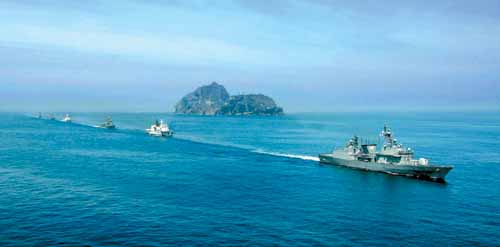Is U.S. Dokdo change part of a bigger shift?

A South Korean destroyer and other naval vessels participate yesterday in a joint defense drill off the Dokdo islets. The military exercise took place amid rising tensions between Japan and South Korea over sovereignty on the islets. The drill included P-3C reconnaissance planes and the Air Force’s newest fighter jet, the F-15K. Provided by the Kor
But this latest development may only be the tip of the iceberg. What lurks below could be a fundamental shift in Washington’s diplomacy in the Asia- Pacific region that could see the United States distancing itself from South Korea while beefing up its military alliance with Japan.
Already there are signs that this is happening.
The BGN, which sets the standards for American government agencies, recently relabeled the disputed islets in the East Sea, long controlled by South Korea, from a South Korean territory to an area with uncertain sovereignty.
Washington said the change, made by geographic experts, has no political motive and was not connected to the recently renewed row between Seoul and Tokyo over the islets. But the agency’s online Geonet Names Server still considers other areas under territorial dispute, for instance, the Kuril Islands or Senkaku Islands, to belong to the countries that actually control them.
And the latest change may be in line with Washington’s long-term policy of forging greater military ties with Japan, experts say.
Since the Cold War ended, the U.S. has been steadily working to restructure its military presence in East Asia by putting more focus on Hawaii and Japan, they note.
As part of the plan, the U.S. has been reducing its military presence in South Korea while enhancing integration with Japanese Self-Defense Forces.
By 2012, wartime operational control in Korea will be handed over to the South Korean military from the Republic of Korea-U.S. Combined Forces Command. And the combined forces of the two countries will be dismantled ? meaning military ties between the two countries are likely to be weaker than before.
The change also means the South Korean military will be the central player in case of a possible threat from or a war with the North while the U.S. military only plays an assisting role.
And U.S. military forces in Seoul will soon be relocated to Pyeongtaek, Gyeonggi, physically separating the two countries’ main military bodies. At the same time, there are plans to move the headquarters of the U.S. Eighth Army to Hawaii.
In contrast, the Pentagon is increasingly integrating its military presence in East Asia with the Japanese military. For instance, the U.S. First Army base in Fort Lewis, Washington State, will be relocated to Camp Zama in Japan by the end of this year.
Camp Zama is home to the U.S. Army Japan, the United Nations Command (Rear) and the Third Engineer Group of Japan’s Ground Self-Defense Force. The camp will soon become the integrated operations headquarters commanding the army, navy and air forces of the two countries.
In another signal of the increasingly closer alliance between the two countries, U.S. Secretary of State Condoleezza Rice called Japan and Australia part of America’s “democratic alliance.” She called Korea a “global partner.”
South Korea’s President Lee Myung-bak faces the hard chore of strengthening South Korea’s position in U.S. international diplomacy.
“To be perfectly honest, Korea is quite behind Japan in terms of diplomatic power,” said another researcher at the state-run institute who declined to be named. “And we now face a really daunting task to expand our political leverage amid the latest diplomatic blunders. The upcoming presidential summit will be a good opportunity to explore the possibilities.”
“The government may need to reconsider the transfer of wartime operational control, map out details for the Korea-U.S. strategic alliance and wisely negotiate sharing the cost of U.S. military operation here,” said Yun Duk-min, professor at the Institute of Foreign Affairs and National Security. “The South also needs to beef up support for major think tanks and Korea experts in the United States.”
By Kim Min-seok JoongAng Ilbo/ Jung Ha-won Staff Reporter [hawon@joongang.co.kr]










with the Korea JoongAng Daily
To write comments, please log in to one of the accounts.
Standards Board Policy (0/250자)